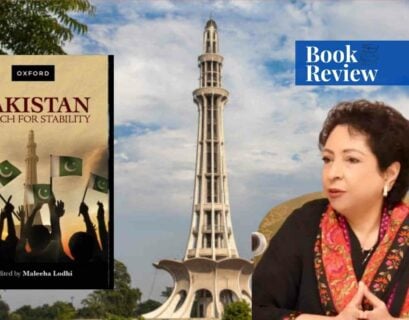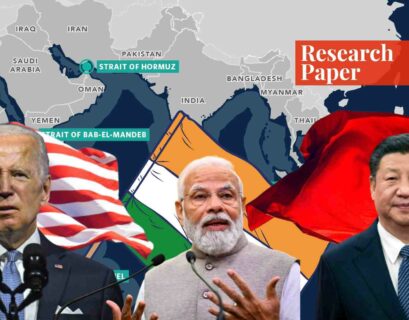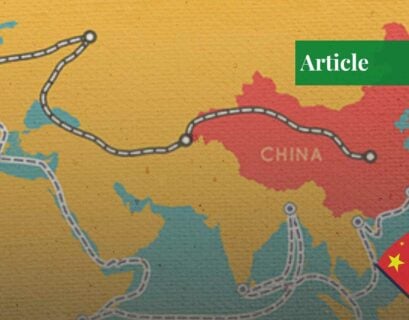Paradigm Shift is an official staff account.
Introduction
Human nature is extremely complex, and it is even more convoluted to define human nature as being good or bad. Plenty of research has been done on understanding human nature and why we behave the way that we do. All social sciences, including sociology, anthropology, economics, psychology, political science, approach the same question through various lenses. This paper addresses human nature from the perspective of political science; it explains how states following two different ideologies, neo-Confucianism and neo-liberalism, have dealt with the coronavirus.
The paper also discusses the effects of this nature on state governance based on social, political, economic, psychological, and philosophical tenets. Furthermore, it explains how major powers like China and the US along with other nation-states, while believing in varying state ideologies, are dealing with the novel coronavirus outbreak.
To gain a better understanding of the systems and ideologies of these states, a thorough analysis of their fundamental economic and political underpinnings is carried out, under the light of Neo-Liberalism and Neo-Confucianism. Once that understanding has been established, quantitative and qualitative research done on Covid-19 in the US and China reveals the administrative efficiency, bureaucracy, and readiness of these states in response to the pandemic.
This makes it possible to assess, based on the given data, analytical tools, and other statistical predictions, which states and which ideological approach, neo-liberalism or Neo-Confucianism, dealt with or have the capacity to deal with the coronavirus effectively and efficiently.
The Impact of Socialization on Human Nature
Historically speaking, two schools of thought broadly define human nature in political science. The Hobbesian school of thought depicts human nature as evil, selfish, brutal, and corrupt. No matter what the circumstances are, Thomas Hobbes’ realism theory portrays life as a zero-sum game and perceives that one can benefit only at the expense of someone else.
However, the liberal school of thought is the opposite of it. This school defines human nature as a dual entity where man does what he is obliged to do under different circumstances. So, human nature is both good and bad according to the liberal school, while it is only bad according to Hobbes. For the followers of the Hobbesian school, human nature is universal, while it is culturally relative for the liberals.
Human beings have different socialization processes that act as ways to restrict them from acting in their naturally violent behavior, as a man in a “state of nature” is lethal according to Hobbes. Therefore, different forms of socialization processes play key roles in restricting man’s innate forceful behavior. For instance, socialization processes comprise of culture, norms, values, ethics, religion, and institutions to make people behave in a certain manner.
The modern state is considered a sovereign in international politics, giving it the right to use power against its citizens. The power contours of states believing in different philosophical, political, economic, and cultural ideologies vary. Some states have more power than others and within these states, states like the US have empowered their masses to the extent that it has resulted in a complex bureaucratic-government nexus. While states like China leave little minimal room for individualism and place more emphasis on collective, cultural values.
Traits of a Neo-Liberal State
In contemporary comparative politics, two main approaches, namely the neo-liberal and Neo-Confucian state models, can be used to study state structures and administrations. At a basic level, modern China represents a Neo-Confucian state whereas, the US is an ideal representative of a neo-liberal state.
A neo-liberal state is underpinned by the works of classical liberal scholars such as Jean-Jacques Rousseau, John Locke, and John Stuart Mill, etc. There are four key traits of a neo-liberal state:
- Free Market Economy
It entails the free flow of goods and services through various international borders without any trade tariffs and state intervention. It encourages private ownership of property and leaves the pricing of commodities to the market.
- Democracy
Democracy ensures that every citizen of the state has the right to vote and partake in the electoral process.
- Juridical Equality
Every citizen of the state is equal according to the law. It is the job of the judiciary to make sure that all the citizens are treated equally and without an ounce of discrimination.
- Liberty
Neo-liberalism retains—like the other variations of the liberal political thought—individual liberty in terms of thinking, voting, and private ownership of property, at its center.
In a practical sense, the US sounds one of the biggest proponents of these ideas, followed by various European countries, such as England, France, Germany, and Italy, etc. Historically, these tenets emerged under the influence of the European Renaissance and industrialization.
During these times, the rural elite and the urban elite of Europe were in a dire need to bring forth new ideas to cultivate a new political and economic system, capable of working for an individual and his political and economic liberty. Thus, under the radar of individual liberty, free-market economy, juridical equality, and democracy, a new version of a social reality took place which eventually replaced the monarchic and religious nature of western states.
Traits of a Neo-Confucian State
A Neo-Confucian state is the one deeply ingrained in Confucian philosophical models, amalgamated with modern societal needs. There are five key characteristics of a Neo-Confucian state.
- Flexible Hierarchy
Flexibility in the hierarchy is necessary to maintain the existing social order.
- Enlightened Authoritarianism
Authoritarianism is amalgamated with a consensus-based advising committee. Neo-Confucian states maintain a distinction in the private and public aspects of people’s lives. States like China do not intrude into the private aspects of their individuals.
- Intellectual Merit
Intellectual merit is considered a top priority for Neo-Confucian states. They take corruption and inefficiency very seriously.
- Centralized Bureaucratic Administration
Power is more concentrated, making it possible to effectively implement administrative policies.
- Communitarian Approach
The state’s main focus is to empower the community as a whole and not just the individuals.
Currently, China ideally represents this state model, with some other states like Japan and Singapore, comprising of a few of these Neo-Confucian traits. Unlike the US, where individual empowerment is the basic tenet of the state structure, the Chinese communitarian approach focuses on the communal needs of the society. Furthermore, these Chinese tendencies are highly rooted in their ethical Confucian teachings which highly regard tradition and value systems for the coherence of the state structure.
The Covid-19 Pandemic: Cases and Casualties
From May 2020 to January 2021, the total number of Covid-19 cases was 3,388,936 with 238,937 deaths, out of which 1,076,390 people recovered. Among the active cases in January, 98% were in mild condition while the remaining 2% were in a serious condition. In the closed cases, 82% of people recovered, while 18% died. However, due to new variants of the virus, the pandemic has become even deadlier.
Out of all the cases mentioned above, 1,123,764 cases and 65,457 deaths were reported in the US alone. This puts the US at the top of the list of the most coronavirus-related deaths and cases. Behind the US, more than 24,000 people died in Italy, UK, Spain, and France till the first month of 2021. On the other hand, China reported a total of 82,874 cases and 4,633 during this period.
An interesting fact here is that the virus originated in Wuhan, China, yet it has affected the western world, i.e. Europe and the US, more. Statistically speaking, the China, the country representing Neo-Confucianism, wass the most affected nation but the way it managed to control the coronavirus is not only remarkable but also exemplary for other countries.
As the virus initiated in China, western countries had plenty of time to make relevant arrangements beforehand yet the facts speak for themselves. Various parts of China are already witnessing a new normal where shops and businesses have already started to reopen (Zhong, 2020).
Coronavirus in Spain
In Spain, the government reacted late even though it had plenty of time to learn from China, Italy, and Iran. It lacked resources such as ventilators, testing kits, and protective clothing. The government, led by Pedro Sanchez, took more than a day to put “emergency powers” into real practice; it led to the free intermingling of people and the initial spread of the virus.
In response to the outbreak, people initially enjoyed the lockdown in bars, parks, and beaches. However, this was short-lived as the virus added to the financial crisis, unemployment, and public debt of the country (Tremlett, 2020). The economist Toni Roldán calculated that Spain needs a €200bn loan from the European Stability Mechanism (ESM) (Tremlett, 2020).
COVID-19 in Italy
In Italy, the virus was not taken seriously in its initial stages. Strict actions were not taken even though scientists warned about it. Not only that, but some politicians also paid no heed to “social distancing”, even as a positive message to encourage people. One of the politicians eventually got diagnosed with the virus, compelling the government to announce partial lockdowns.
The decentralized nature of Italy’s healthcare institutions in different parts of the country added to the problem with varying policy responses. The different levels of the Italian government had no idea how to approach the issue at hand (Pisano, 2020).
The United Kingdom and the Pandemic
In the UK, even Prime Minister Boris Johnson was infected by the virus. The UK government came up with a different approach to tackling the virus at its early stages. They planned to implement “herd immunity”, “which is to have the majority of the population contract the virus, develop antibodies and then become immune to it (Toby Helm, 2020).”
After a month of the virus being introduced in the UK, the cases started to increase exponentially, causing everything to close down. Around 1 million people asked for unemployment benefits in the UK at the end of March last year (Lora Jones, 2020).
Referring to this, The Guardian states, “There is no question that we were insufficiently prepared” (Toby Helm, 2020). Furthermore, CNN reported three key reasons for the massive corona debacle (Luke McGee, 2020). These reasons were :
- Lack of mass testing facilities.
- Late lockdown.
- The “herd immunity” approach
COVID-19 in the United States
In the US, the economy is badly damaged, and the virus has put many under unemployment. The most basic items needed for the protection of medical professionals, i.e. masks, gloves, gowns, and ventilators, were short in many states.
In addition to that, testing delays led to the blind spread of the virus throughout the country. The administration aimed to conduct 5 million tests by the end of March 2020, while in fact, it only conducted a million (Zurcher, 2020). Following the pandemic, unemployment in the US reached new heights. 30 million people filed for unemployment benefits in just December (Jones, 2020).
The Trump administration also faced immense contradictions in its official statements about the lockdown and reopening of businesses, leaving the masses with unclarity and confusion, which eventually added to the panic.
The former administration continuously failed at implementing “social distancing measures”. Various events in Florida, New York, and Louisiana were conducted where large groups of people were invited. The virus threat was considered “politically motivated” (Zurcher, 2020).
COVID-19 in China
In China, the origin place of the virus, the cases did not exponentially increase with the same ratio as the US, the UK, Italy, and Spain. This is contributed to their strict lockdown, social distancing measures, public monitoring of citizens, and punishment and rewards for adhering to the given rules (Kuo, 2020).
The World Health Organization (WHO) appreciated China’s efforts to control the virus in an extremely efficient manner. The Guardian states, “China’s ‘bold approach’ had changed the course of a rapidly escalating and deadly epidemic.”It added, “In the face of a previously unknown virus, China has rolled out perhaps the most ambitious, agile, and aggressive disease containment effort in history (Kuo, 2020).”
They turned their stadiums and other such places into quarantine zones and built hospitals to house patients having any minute symptoms (Kuo, 2020). Subsequently, The Guardian further highlighted “Aylward and the WHO said China’s most effective measures were ‘extremely proactive surveillance’ to detect cases, extensive testing and immediate isolation of patients, rigorous tracking and quarantine of close contacts and an ‘exceptionally high degree of population understanding and acceptance’ of such measures (Kuo, 2020).” These Chinese policies have proven to be effective against COVID-19.
Two Sides of the Blame Game
COVID-19’s contagiousness is mind-boggling and has proven to be lethal. Considering only the facts and numbers vis-à-vis the coronavirus and its potential to damage the global system, the states associated with Neo-Confucianism seem to be on the relatively better side to control it. However, there is much more to that than a mere analysis of statistical and visual data. A blame game has started already from both China and the US regarding who initiated the virus.
The Western Side
The Guardian states, “Donald Trump, the House minority leader, Kevin McCarthy, and other elected officials have called Covid-19 the ‘Chinese virus’ and one White House official reportedly called it the ‘Kung Flu’. The Republican senator Tom Cotton hinted (without evidence) that the virus could be a bioweapon created by the CCP (Fuchs, 2020).”
It further stated, “In China, a spokesman for the PRC ministry of foreign affairs lied in suggesting that the US military could be to blame for the virus. Chinese government officials have echoed that sentiment while the CCP’s propaganda machine is busy promoting these conspiracy theories (Fuchs, 2020).”
The race to come up with a vaccine to emerge as a new global savior is at the forefront of academic circles’ discussions. Furthermore, the western liberal media sources are questioning the authenticity of figures provided by the Chinese government regarding the virus cases. These numbers look skeptical to the western media due to China being the origin place of the virus and the massive damage the virus brought to the western world.
The Guardian also published, “It’s important to get the facts right. The virus started in China. In the early days, doctors tried to sound the alarm but were not allowed to do their jobs. As the virus spread, the CCP censored many of those attempting to raise alarm bells. The CCP’s botched initial response to the virus probably made this pandemic far worse (Fuchs, 2020).”
The Chinese Side
Alternatively, the Chinese news sources appreciate their government’s efforts and criticize the management of the virus by the US. Their sources say that the strategies shared by the representative of Neo-Confucianism are helping other countries in containing the coronavirus with stringent measures and lockdown. These sources argue that the US is responsible for spreading the virus due to its weak policies and its inability to contain the pandemic.
State news outlet Xinhua re-published an analysis from an independent blogger’s WeChat account, which said, “The US owes China an apology, the world owes China thanks (Steger, 2020).” The article also stated, “There is also glee in some quarters with what so far has been a slow response by the US government (Steger, 2020).”
Analysis
Considering the above discussion, it is evident that there were various structural and administrative problems in countries like Spain, Italy, the UK, and the USA, which led to the failure in prohibiting the proliferation of the virus.
The key problems vis-à-vis their approach to tackling the virus include the lack of communication and tussle between federal and regional governments, difficulty to conduct lockdown beforehand, inconsistent statements from the government officials, people’s tendency to ignore the government issued orders, governments’ ineffective plans, testing delays, unemployment, and economic crashes.
On the other hand, China despite being an authoritarian state following Neo-Confucianism, did not find it difficult to impose a lockdown to contain the coronavirus. It imposed strict punishments for not following the precautionary measures. Simple policy lines coming from the government, followed by the locals without disruption, made it possible to build hospitals, provide effective testing services and arrange quarantine zones quickly without any bureaucratic delays (Kuo, 2020).
Capitalist countries such as the US are already deeply indebted to a Neo-Confucian state—China—which tells us how dependent and weak a neo-liberal economy is. The neo-liberal model does not seem to be surviving in the long run because of the illusive nature of the philosophical and practical underpinnings of neo-liberalism. It seems to serve the interest of the urban elite more than the interest of the citizens of the state.
While Neo-Confucianism enables the state to act as a big brother to the citizens of the state and takes care of them by increasing their odds of survival. Being a follower of Neo-Confucianism, China has done exactly that during the coronavirus pandemic. Whereas, in a neo-liberal state, individuals are given the so-called autonomy to make their own political and economic decisions, while their hands are tied as the same political and economic elite control all the resources.
The pandemic is a great example to understand why capitalist countries like the USA and UK are affected the most and unable to control the pandemic, even though they had the best healthcare systems in the world. On the other hand, the representative of Neo-Confucianism, China, built hospitals in a few days and tried to control the coronavirus as much as possible (MAÇÃES, 2020).
This also provides us a glimpse of how a Neo-Confucianism and the states adopting adhering to it deal with emerging problems as big as the coronavirus, and how the capitalist state gets paralyzed when the demand for public healthcare increases unexpectedly (MAÇÃES, 2020).
So, one can argue that administratively efficient states can control and react quickly to unpredictable circumstances, while the states which focus more on the mere distribution of power and individual liberty get stuck as European countries are.
Countries being reluctant to impose strict measures and to penalize the citizens for disobeying the law were unable to handle the virus efficiently. On the other hand, China having authoritarianism as its political, economic, and administrative system, and Neo-Confucianism as it ideology, was able to put all required actions on time leading to the effective control of the coronavirus and ensuring the safety of its citizens.
International Diplomacy
Moving towards the international diplomacy part of both neo-liberalism and Neo-Confucianism, one can see how the new Chinese model is tangibly benefitting the locals in the global South directly even during the onslaught of the coronavirus. The Chinese are building complete ports for the underdeveloped world and making other infrastructural improvements to increase employment and improve standards of living so that the poor individuals get benefitted (Philippe Bonnet, 2018). It contradicts what a neo-liberal country like the US does.
The US makes cordial relations with the ruling elite of the Third World and then provides funds so that the interests of both sides get fulfilled (Callahan, 2016). The ruling elite in underdeveloped countries hardly make those funds work for the masses because of corruption and inefficiency, and the immense cycle of poverty keeps on running.
While the Chinese take a personal interest in the development of these countries and want them to prosper in the real world, instead of selling the ideology of individual liberty, democracy, and capitalism. The Chinese are focused on tangible development which brings fruits for both countries, while the American model seems to be failing.
Pakistan as an Example
One interesting example, in this case, can be of Pakistan which remained a close friend of both China and the US. Pakistan fought two massive, funded, wars for the US in the last four decades. These wars damaged Pakistan’s global reputation and brought terrorism to it. The only benefactors from the wars seem to be the ruling elites in Pakistan, who had control over an immense amount of money. The poor of the country suffered the most because of the national concentration on the “war economy”.
On the other hand, the Chinese never used Pakistan as a pawn and are going to build one of the largest economic corridors in the world in the form of the China-Pakistan Economic Corridor (CPEC), which is full of infrastructural development coupled with massive economic growth. Thus, Neo-Confucianism ensures that states like China not only benefit their local citizens but also take care of their poor international allies by bringing tangible development, and support in dire situations, much like the ongoing coronavirus pandemic.
Critique on Neo-Liberalism
All the above-mentioned traits of neo-liberalism seem pertinent only when discussed in theory. When it comes to what appears on the ground, these neo-liberal traits seem to be somewhat idealistic and used merely to exploit the masses and sustain the current politico-economic system. For instance, the state intervention in the economy, the relative notion of juridical equality, and the illusive nature of the idea of liberty—all these features of a neo-liberal state seem quite idealistic yet problematic in nature, if fully implemented.
Ideas of liberty, individualism, private property, and democracy were the need of the hour, during the industrialization period in Europe, to make the rural poor migrate to cities and earn better wages in urban industries. These ideas even created the illusion that the workers were free beings who had choices to make regarding their individual, economic and political decisions.
Interestingly, the urban elites in the capitalist western world are no longer capable of sustaining that illusion because of the emergence of alternative models in the form of Neo-Confucianism in China or democratic socialism in the Scandinavian countries. These new models challenge the old age ideas of individual liberty and philosophically explain the merits of a communitarian over individualistic approach.
The rising tide of poverty, decreasing social mobility rates, increasing debts, ongoing corruption, and inefficiency, weaken the neo-liberal state models and make the individual states rethink their politico-economic models to bring efficiency and stability (Bank, 2019). it also makes the general populace compare states like the US with their communist/socialist rivals. In the case of the coronavirus, this comparison is made between Neo-Confucianism and neo-liberalism.
Critique on Neo-Confucianism
One of the most convincing critiques on Neo-Confucian states is the lack of ethnic, cultural, and religious diversity. Neo-Confucianism works only on a community that has ethnic, cultural, and religious similarities so that it becomes easier to implement certain policies for the betterment of the whole community, which can be seen during the coronavirus pandemic.
In the recent scenario, China is criticized for its treatment of the Uighur Muslims because the state thinks that various religious practices of these Muslims are antithetical to their social stability. Therefore, they are taking strict actions against them.
Conclusion
To bring it all together, the neo-liberal states do not seem to be tackling the emerging problems of contemporary times such as poverty, unemployment, and the social mobility of citizens. Their created illusions can keep people content only for a certain period. In the long run, people realize that the state at the top is the same people running the show all the time. This argument is also linked with democracy.
In the US, elections are held every four years. Therefore, the ruling president has to put his level best to perform in those four years. So, his administration makes policies that please only the ruling elite in the long run, and people only benefit for a small period.
However, in China, their “enlightened authoritarianism” coupled with Neo-Confucianism provides the state with legitimacy to introduce policies, like those implemented to control the coronavirus, that benefits citizens directly and can sustain in the long run. So, considering the traits of both neo-liberalism and Neo-Confucianism and the way states like the UK, USA, Spain, and Italy dealt with the coronavirus, we can conclude that the former is declining at a massive rate. However, the traits of the latter sound more convincing in terms of administrative efficiency and tackling the emerging problems more quickly and effectively.
References
- Bank, T. W. (2019). Poverty. The World Bank. https://data.worldbank.org/topic/poverty?locations=EU-US-CN
- Bonnet, P., & Martin, A. (2018, November 21). An EU Strategy on connecting Europe to Asia… the European way? The Asia-Pacific Circle. https://asiapacificcircle.org/asia-pacific-insights-trends/an-eu-strategy-on-connecting-europe-to-asia-the-european-way/
- Callahan, W. A. (2016). Chinas “Asia Dream”: The Belt Road Initiative and the new regional order. Asian Journal of Comparative Politics, 1.
- Fuchs, M. H. (2020, March 31). The US-China coronavirus blame game is undermining diplomacy. The Guardian. https://www.theguardian.com/commentisfree/2020/mar/31/us-china-coronavirus-diplomacy
- Helm, T., Graham-Harrison, H., & McKie, R.. (2020, April 19). How did Britain get its coronavirus response so wrong? The Guardian. https://www.theguardian.com/world/2020/apr/18/how-did-britain-get-its-response-to-coronavirus-so-wrong
- Jones, L., Brown, D., & Palumbo, D. (2020, April 30). Coronavirus: A visual guide to the economic impact. BBC. https://www.bbc.com/news/amp/business-51706225
- Kuo, L. (2020, March 09). How did China get to grips with its coronavirus outbreak? The Guardian. https://www.theguardian.com/world/2020/mar/09/how-did-china-get-grips-with-coronavirus-outbreak
- MAÇÃES, B. (2020, March 10). Coronavirus and the Clash of Civilizations. National Review. https://www.nationalreview.com/2020/03/coronavirus-and-the-clash-of-civilizations/
- McGee, L., & Krever, M. (2020, May 01). Where did it go wrong for the UK on coronavirus? CNN. https://edition.cnn.com/2020/04/30/uk/britain-coronavirus-missteps-boris-johnson-analysis-gbr-intl/index.html
- Pisano, Gary P., Sadun, R., & Zanini, M. (2020, March 27). Lessons from Italy’s Response to Coronavirus Harvard Business Review. https://hbr.org/2020/03/lessons-from-italys-response-to-coronavirus
- Steger, I. (2020, March 06). China is taking pleasure in US mishandling of coronavirus. Quartz. https://qz.com/1813181/china-is-taking-pleasure-in-us-mishandling-of-coronavirus/
- Tremlett, G. (2020, March 26). How did Spain get its coronavirus response so wrong? The Guardian. https://www.theguardian.com/world/2020/mar/26/spain-coronavirus-response-analysis
- Zhong, R., & Wang, V. (2020, April 17). China Ends Wuhan Lockdown, but Normal Life Is a Distant Dream. The New York Times. https://www.nytimes.com/2020/04/07/world/asia/wuhan-coronavirus.html
- Zurcher, A. (2020, April 01). Coronavirus: Things the US has got wrong – and got right. BBC. https://www.bbc.com/news/world-us-canada-52125039
If you want to submit your articles and/or research papers, please check the Submissions page.
The views and opinions expressed in this article/paper are the author’s own and do not necessarily reflect the editorial position of Paradigm Shift.



















